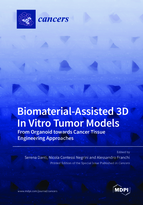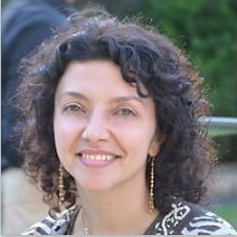Biomaterial-Assisted 3D In Vitro Tumor Models: From Organoid towards Cancer Tissue Engineering Approaches
A special issue of Cancers (ISSN 2072-6694).
Deadline for manuscript submissions: closed (1 March 2022) | Viewed by 52056
Special Issue Editors
2. Department of Civil and Environmental Engineering, Massachusetts Institute of Technology (MIT), Cambridge, MA 02139, USA
Interests: electrospinning; biomaterials; biomedical polymers; piezoelectric materials; smart materials; tissue engineering; advanced in vitro models
Special Issues, Collections and Topics in MDPI journals
Interests: sinonasal cancer; synovial chondrosarcoma;ameloblastic fibrosarcoma; clinical pathology
Special Issues, Collections and Topics in MDPI journals
Special Issue Information
Dear Colleagues,
The structural and biological complexity of tumors represents a great challenge for the development of effective therapies and drugs. Traditional in vitro cultures are inherently bi-dimensional (2D), whereas in vivo animal models are inherently nonhuman and therefore affected by drawbacks that slow down and limit advancements in cancer research. In this scenario, biomaterial-assisted 3D in vitro models are currently catalyzing high interest, as they can provide more reliable answers toward a better understanding of tumor biology and personalized screening of existing and new therapies. By using biomaterials to generate 3D structures, such as hydrogels and porous scaffolds, 3D in vitro models can overcome the oversimplification of traditional cell cultures by offering a physiological-like microenvironment for cancer cell growth and interaction with diverse cell types. Moreover, these models are not affected by the variability and ethical issues related to in vivo animal models, thus representing a powerful tool in cancer research.
The potential of biomaterial-assisted approaches, including organoids and tissue engineering, for the development of in vitro cancer models, has opened up exciting frontiers and associated new challenges to be tackled in order to obtain cellular constructs that correctly resemble the tumor/pathological microenvironment. These challenges regard the choice of the biomaterial, the set-up of appropriate fabrication technologies able to control physical, mechanical, and biological cues so as to resemble in vitro the complexity of the pathological tissue, the understanding of the cancer cell/biomaterial interaction, the obtainment of multicell type constructs, and their standardized use for new drug/therapeutic discovery, as well as the study of cancer development, progression, and metastasis within such 3D microenvironments.
This Special Issue covers current research (by original research papers, review articles, and short communications) that focuses on the development and study of innovative biomaterial-assisted strategies to recapitulate in vitro, within a 3D microenvironment, the formation of cancer, the spread of metastasis, and all the related aspects aimed to provide an advancement in the study of tumor pathology for oncologic research to be also implemented for drug screening.
Dr. Serena Danti
Dr. Nicola Contessi Negrini
Dr. Alessandro Franchi
Guest Editors
Manuscript Submission Information
Manuscripts should be submitted online at www.mdpi.com by registering and logging in to this website. Once you are registered, click here to go to the submission form. Manuscripts can be submitted until the deadline. All submissions that pass pre-check are peer-reviewed. Accepted papers will be published continuously in the journal (as soon as accepted) and will be listed together on the special issue website. Research articles, review articles as well as short communications are invited. For planned papers, a title and short abstract (about 100 words) can be sent to the Editorial Office for announcement on this website.
Submitted manuscripts should not have been published previously, nor be under consideration for publication elsewhere (except conference proceedings papers). All manuscripts are thoroughly refereed through a single-blind peer-review process. A guide for authors and other relevant information for submission of manuscripts is available on the Instructions for Authors page. Cancers is an international peer-reviewed open access semimonthly journal published by MDPI.
Please visit the Instructions for Authors page before submitting a manuscript. The Article Processing Charge (APC) for publication in this open access journal is 2900 CHF (Swiss Francs). Submitted papers should be well formatted and use good English. Authors may use MDPI's English editing service prior to publication or during author revisions.
Keywords
- in vitro tumor model
- 3D cell culture
- cancer model
- scaffold
- biomaterial
- organoid









